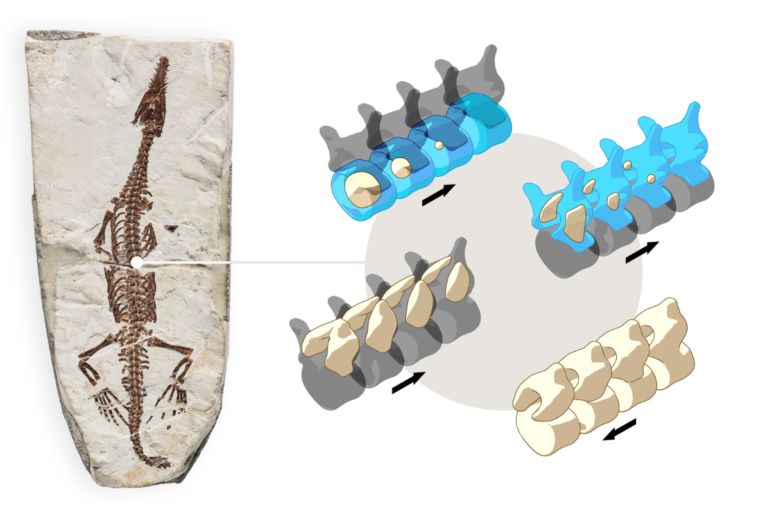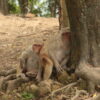A study conducted by researchers from the Museum für Naturkunde in Berlin revealed the evolution of ossification patterns in the backbones of four-legged vertebrates. Antoine Verrière and his colleagues were able to reconstruct the patterns of how the bones in the vertebral column formed in the ancestor to all land vertebrates based on a large dataset of modern and fossil vertebrates with the inclusion of rare new data from the 300-million-year-old reptile Mesosaurus tenuidens. The results are published this week in Scientific Reports.
The backbone or vertebral column is the defining and name giving feature of all vertebrates and its development is generally well understood. However, some crucial parts of its evolutionary history remain enigmatic. A new study by a team from the Humboldt-Universität zu Berlin and the Museum für Naturkunde in Berlin, Germany, uncovers new aspects of this history.
Paleontologist Antoine Verrière, first author of the study conducted as part of his doctoral research, says the project started with exceptionally well-preserved fossils of the reptile Mesosaurus tenuidens. Mesosaurus was the first reptile to adapt to life in water. With a long snout and powerful swimming tail, it inhabited an inland sea in the southern parts of the supercontinent Pangaea.
“On some rare juvenile specimens, we observed that the neural arches, the spines sitting on top of the main part of a vertebra, were closing from head to tail as the animals grew, much like a zipper. We wanted to understand how this pattern would fit in the evolutionary history of land vertebrates, but quickly realized there was surprisingly little information available. So we decided to investigate this ourselves.”
The team looked at four of the major developmental patterns in the vertebral column of amniotes:
The ossification of the centrum (the main body of a vertebra)The ossification of paired neural archesThe fusion of the initially forming paired neural arch elements into one spineThe fusion of neural arches with the centrum, also called neurocentral fusion.
They used statistical models to retrace how these various patterns have changed throughout the roughly 300 million year long history of land vertebrates and with this could reconstruct the patterns in the common ancestor to all land vertebrates.
“What surprised us the most was that these patterns appear to have been relatively stable for the last 300 million years,” Prof. Jörg Fröbisch says. “Modern and extinct vertebrates are enormously diverse in terms of their body shapes and lifestyles and the elements of their vertebral columns are organized in complex units that differ greatly between species. Nevertheless, the ossification patterns were much more conservative than was expected from the great morphological diversity.”
Although the studied patterns have been relatively stable throughout evolution given the enormous time range considered, some deviations did occur. Notably, birds, mammals, and squamate reptiles each evolved their own specific modes of vertebral ossification, which differ from the ancestral condition in amniotes. Yet again, within these groups, the patterns were also surprisingly stable.
“Ostriches and seagulls, for instance, have very different anatomies and lifestyles, but their vertebral columns ossify in similar ways. This shows that some changes can be observed between the major lineages of land vertebrates, but within each of the main lineages, spine development remained rather stable again,” Prof Nadia Fröbisch says.
“Our study is another great example how data from fossils and modern animals can come together to really gain a much deeper picture of the development and evolution of major of body structures,” Antoine Verrière says.
More information:
Antoine Verrière et al, Regionalization, constraints, and the ancestral ossification patterns in the vertebral column of amniotes, Scientific Reports (2022). DOI: 10.1038/s41598-022-24983-z
Provided by
Museum für Naturkunde
Citation:
The vertebral column develops in the same way in modern animals as it did 300 million years ago (2022, December 29)



